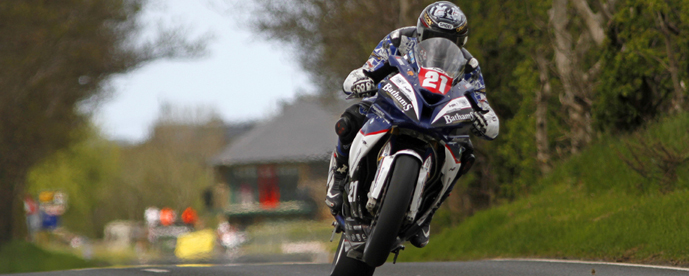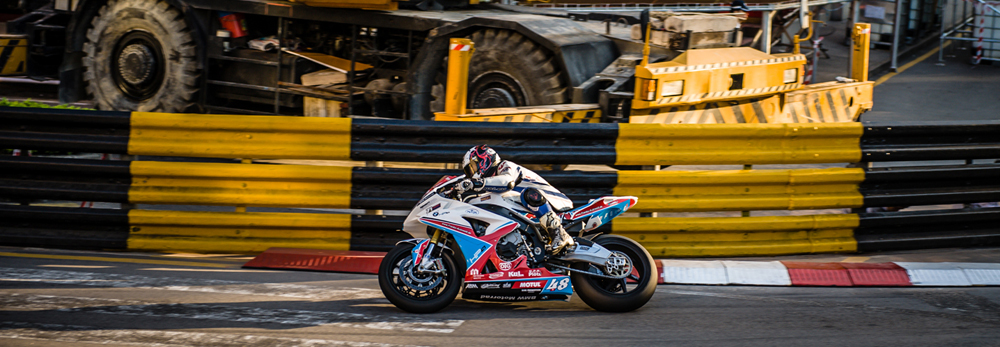Races
 © Diego Mola // www.diegomola.com
© Diego Mola // www.diegomola.comInternational North West 200
Cut from the same bolt as the Isle of Man race, the North West 200 is an annual road race in Northern Ireland, taking place on public streets linking the towns of Portstewart, Coleraine and Portrush. A demanding course in its own right, the 8.9 mile Northwest 200 on the closed public roads course in Portrush Northern Ireland is traditionally the place where riders and teams make ready for the following real road event, the Isle of Man TT.
With speeds attained of over 200mph for the fastest bikes in the Superbike class and changeable weather conditions usually part of the challenge, the North West 200 is a festival of racing that is always well attended.
Conceived in 1929, the North West 200 has suffered few fatalities despite the high speeds and nature of the course, which is surprising given the concessions to safety - some street signs are removed, and bales of hay are wrapped around lampposts and telegraph poles.
If it's a riotous exhibition of what it is to be alive you're after, then make the trip to Northern Ireland. The North West 200 might be UK's biggest, most thrilling sporting event you've ever heard of. And for the 150,000 punters, if it's sunny, which is doubtful, it doubles as a sobering lesson in the authentic.
'Some people think it's ridiculous,' says John McGuinness, six-time winner at the North West, 'sitting on a bike going at 200mph. But you're not alive if you don't get excited by it: the sound and smell of bikes, wheel-to-wheel racing, 18 inches away from the next rider, grandstand finishes. I don't care what anyone says, everyone loves bikes. Stick your head out of the sunroof of a car travelling at 80mph and see how it feels. Now imagine travelling at 200mph and doing the same thing. In truth, we don't have time to think about how it feels. The only time it feels that fast is when something goes wrong. Then everything speeds up a little bit.'
Nevertheless, McGuinness is keen to point out that he and his comrades amount to a whole lot more than 'a bunch of lunatics howling around a road', saying, 'We're professional sportsmen.'

Isle of Man Tourist Trophy
Never mind your Silverstones and your Hockenheims; let's take a gander at the Isle of Man TT race. Talk to any professional or semi-professional motorcycle racer and few would deny a hankering to take it to the absolute limit. Just to see what they and their bike are made of.
The TT – or Tourist Trophy – was first held in 1907. The public road track was lengthened from 15 miles to the full 37.75m Snaefell Mountain course in 1911, and this is the circuit still used today. These public roads are closed for two weeks every year to become a race track that no video game could hope to emulate.
There are five main classes for motorbikes – Superbike, Senior, Superstock, Supersport and Lightweight. The big races take up to six laps, which amounts to a staggering 226.5 miles in a little over an hour and three-quarters. We'll let you do the maths on the ground covered to time ratio.
The danger to life and limb comes from a combination of mind-numbing speed and the perilously narrow course of 264 corners lined by very hard objects such as stone walls and telegraph poles which have to be anticipated and negotiated at maximum velocity. And when it goes wrong, the outcome can be horrific. This race is not for the fainthearted or the unprepared.
Why? That's the question hanging over this race, which has always been a target for critics calling for it to be stopped. Just why would anyone want to participate in something offering Russian roulette odds of serious injury or death – especially when the financial rewards do not begin to approach the statistically safer environment of, say, MotoGP? And should they even be allowed to? A good place to find an answer is Rick Broadbent's brilliant book on the TT, 'That Near-Death Thing'. The title – which just about sums it up - is a quote from competitor Guy Martin. Martin, talking about a horrific crash he survived at the TT from which he emerged battered but unbowed, said: 'The buzz from that was just unbeatable. That moment between crashing and almost dying. That's raised the benchmark. I want to get back to that point. Money can't buy it. Everything's been so sanitised with bloody PC nonsense and health and safety that there's nothing else, is there? If it was dead safe I wouldn't do it.'
Sounds silly and it is. Looking at other races we might find a more acceptable reason about what makes these guys keep doing it.

Macau Motorcycle Grand Prix
The Macau Grand Prix is the greatest race in Asia but you'd never know it if the only open-wheeled racing you watch is Formula One. That's because the race in the former Portuguese enclave belongs to its little brother, Formula Three.
In many ways, the Macau Grand Prix is the Asian counterpart to the famous F1 race in Monaco. Some say it's Monaco on opium. Set through the very narrow streets of Macau, it features the best up-and-coming drivers in the world, with the winners list inscribed with names such as Senna, Schumacher, Vettel, Rosberg and Hamilton.
Back to the opium – the motorcycle riders vs. armcos must make it one of the most insane races on the planet. Firing down the long straight towards Mandarin and Lisboa corner everything seems just fast and pretty normal – like an ordinary road race. As soon as you wind the throttle going up San Francisco Hill, however, the whole scenery changes and you're literally flying through a labyrinth of armcos and walls – all blind at speeds of up to 150km/h . . . with nowhere to get off. Some call it the most dangerous motorcycle race in the world.
'Nothing I had ever been exposed to in my life as a hooligan prepared me for the dangerous nature of the Macau Motorcycle Grand Prix!', veteran American racer Mark Miller once said about the experience.



